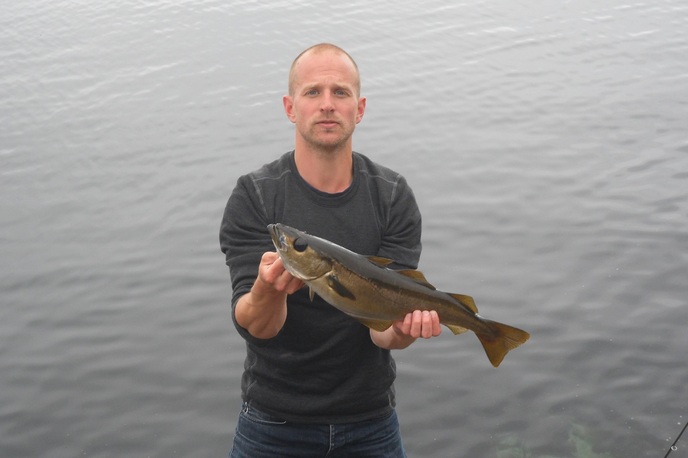
Pollock fishing – 10 tips to catch more pollock
Fishing for pollock (sometimes spelled pollack) is one of my favourite calm weather activities. With its stunning dark colours, the pollock is one of the prettiest looking sea fish. But looks are not the end of it, compared to species like cod, pollock fight incredibly hard. When they’re feeding, pollock are not hard to catch, but there are ways to improve your catch rates dramatically. I’ll get into pollock fishing methods later, first some general tips.
1. Choose the right ground
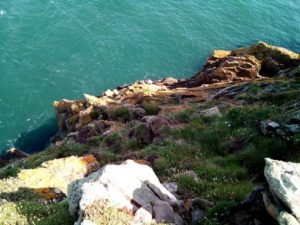
Pollock like rough ground. Reefs and rocky outcrops or even better, wrecks. The more tackle hungry features, the bigger the chance of a decent pollock. Pollock also like kelp because it provides the perfect shelter to ambush their prey from. With their big, upward pointing eyes and protruding lower jaw, the pollock is a hunting machine ‘designed’ to attack its prey from below. Pollock, especially the bigger ones, prefer deep water. Anything over 20/30 ft will do, but 40/50 ft is even better.
Finding the right mark might take some time and effort. Google Earth and Ordnance Survey maps are useful tools when it comes to finding good pollock fishing marks. The better marks are often hard to get to, so make sure you are prepared. For more general information on fishing rough ground, read this post.
2. Choose the right conditions
Calm conditions are best for pollock fishing, especially when using lures. Little wind or offshore wind is best. Rain can also affect pollock fishing – algae covered rocks can turn into a skating rink when they’re wet. Conditions might be perfect otherwise but it’s not worth risking your life.
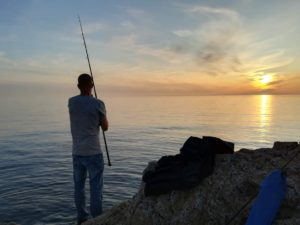
Because of the position of their eyes, pollock see very little in clear bright weather when the sun is high in the sky (‘Fish don’t have eyelashes,’ as someone once pointed out to me.). Therefore early mornings or evenings fish best. It’s not unusual to catch several fish just after sunrise and then nothing for the rest of the day. If it’s overcast, catches can be good during the day too. When the sun is out, deep marks, preferably in the shade, give you the best chances. For more information on sea fishing conditions, read this post.
3. Wear the right shoes
I dare to say that shoes are more important when it comes to pollock fishing than your actual fishing equipment, as getting down to the mark is often the biggest challenge. Sturdy walking boots that provide enough ankle support and have a good grip are essential.
4. Travel light
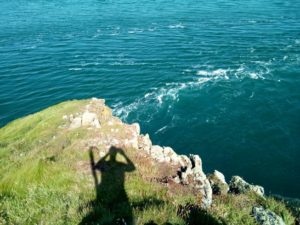
You don’t need a lot of tackle for pollock fishing. A rod and reel, a landing net, lures and some terminal tackle are all you need. A rucksack that you can strap your rod to is ideal, because it leaves both your hands free when you need to climb down to a mark. I tend to spend an equal amount climbing rocks as actually fishing. If you’re the type of angler who likes to fish from the car, this type of fishing is probably not for you.
5. Always bring a landing net
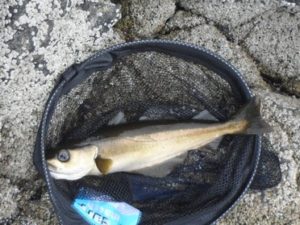
Take as little stuff as possible, but always make sure to bring a landing net. The fish I lost because I failed to land them still haunt me at night (and even during the day, if I’m completely honest). Using a landing net also causes less damage to the fish, which is important if you want to return it. Dragging a fish over barnacle covered rocks is never a good idea.
6. Keep on moving
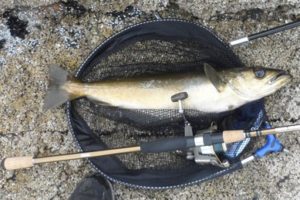
If you stop catching pollock, it’s always a good idea to move to another mark. Pollock fishing is mostly about knowing your marks and when to fish them. For example, some marks might only be accessible at low tide so plan your trip accordingly. Slack tide (the period close to either high or low water) is a good time to move on as bites tend to dry up anyway.
7. Go in 2’s
Fishing together is not only more fun, it’s also a safer, especially on remote rock marks. Pollock fishing is also a lot easier with another pair of hands. A fishing buddy can help to net your fish, take a picture, or hold your tackle while you climb down a steep rock.
If you do go out on your own, always tell someone where you are going and when to expect you back. Unfortunately, reception can be very bad at these kind of locations, so don’t count on your phone.
8. Know your marks
Knowledge is key when it comes to pollock fishing. The more experience you have under your belt and marks in your book the bigger your chances of success. Ideally you have a mark for all conditions. Marks that are safe to fish in wet weather, marks you can easily fish on your own, marks that are nicely sheltered from the wind. Ideally you should always have a plan of which marks you want to fish and in what order.
9. Vary your tactics
Some days you catch loads of fish with the first lure you try, on other days the pollock can be harder to trick. When your whole arsenal of lures doesn’t even get a sniff, a freelined sandeel (more about methods later) can get a take within seconds. Or vice versa.
10. Keep your ear to the ground
As pollock follow the bait fish, there are periods when there simply aren’t any pollock about. This can vary from year to year. They can disappear for months on end only to then suddenly reappear. When sand eel stocks are low in a certain area, the pollock are likely to move to an area where bait fish are more plentiful.
So it’s always a good idea to talk to other anglers/skippers to make sure that pollock are being caught in the area. Conditions can be ideal, but if there’s no pollock around, you’re probably better off targeting other species. If you live further away from the areas you want to fish, keep your eye on the catch reports on fishing forums.
Pollock fishing methods
1. Lure fishing
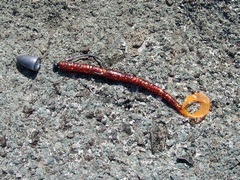
Pollock can be targeted with a large range of lures. Jelly worm type lures can be extremely effective. These lures can be fished weedless which can be an advantage when fishing snaggy ground. They’re also quite cheap so it’s not the end of the world if you lose one. These lures can be fished on a trace, ‘Carolina style‘ but I prefer to fish them ‘Texas style’, with a bullet weight next to the hook, this way I can control the action of the lure more directly. Cheburaska weights also work well. Eddy stone eels, shads, these are all pretty good lures for pollock fishing. Once you stop getting bites on a lure switch to another one. Sometimes a simple change in colour can be enough to seduce them again.
If the soft plastics don’t attract enough attention, spinners might do the trick. I’ve had most success with simple pirk type spinners, but tobys and dexter wedges work well too. Pollock hunt from close to the bottom right up to the surface, so plugs can work really well too. They can even be caught on surface lures.
Lure fishing with braid
I prefer to use braid for my lure fishing because you can ‘feel’ everything your lure comes across (reefs, kelp, etc.). Because braid has zero stretch it’s also easier to stop the pollock from diving into snags. Because the marks I fish are very rough I tend to use a 30lb braid combined with a 20lb mono leader of about 4-6 ft. Check this leader regularly because it will get damaged quickly on these barnacle covered rocks. The leader also works as a shock absorber, preventing the hook pulling out of the fish’s mouth. Some people prefer to use a fluorocarbon leader, but this can get expensive quickly (especially if you have to change your leader several times each session). I find amnesia works really well. When it comes to braided fishing line I found Power Pro to be the most reliable.
Rod-wise, a longish 20-60g rated spinning rod combined with a 3000/4000 size reel is ideal.
2. Float fishing
I love float fishing for pollock. It’s by far my favourite method for the snaggier areas, as you lose a lot less tackle and fish this way. There is often no need to cast, simply lower the float rig next to the rock you’re standing on. By using bigger baits, like a whole fillet of bluey for example, you can target the bigger fish.
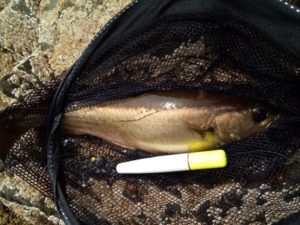
I prefer to use braid for this type of fishing too. Depending on the size of the fish in the area, a carp (for fish up to 5lb) or bass rod (6lb+) is ideal. If there is no need to cast I tie my power gum stop knot directly onto the braid. I like to use a 4ft 20lb amnesia for hook length. The longer hook length also works as a shock absorber/ rubbing leader. For more information about float fishing in the sea, read this post.
3. Freelining
This is probably the simplest way of fishing for pollock. Tie a hook to your mono mainline or leader, hook on a sandeel or sprat, and let the tide take the bait. This method works best when the tide run is relatively gentle, you might have to use a swan shot or two to help the rig sink. On slow days this method can often deliver a fish or two.
4. Bottom fishing for pollock
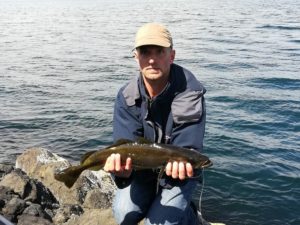
This method works really well in fast tides. On a recent fishing trip I didn’t seem to get past the smaller pollock that would hammer the lure as soon as it would reach mid water. After hours of catching 1-1,5lb pollock I decided to try something else. I used a simple three way swivel to tie this rig with a short weak link and a very long (7ft) trace. This way the bait would be ‘flapping’ above the kelp in the tide. I had to use a 7oz grip lead to hold bottom, casting the rig slightly uptide. I used a whole fillet of bluey on a size 4/0 hook. It took less than 5 minutes before the line went slack and was into a much better fish.
The downside to this type of fishing is that you need much stronger (meaning beach fishing) tackle, but it can really make the difference in the right conditions.
5. Fly fishing for pollock
Although I’m not much of a fly fisherman myself, I know a lot of anglers who prefer to target pollock this way. As there’s often no need to cast, and pollock feed right up to the surface (especially around dusk) this is a great method for pollock fishing. You have to choose the right mark though, as space can be a bit of an issue. Sandeel imitations work really well.
Do you have any pollock fishing experiences you’d like to share? Please do so in the comment section below.
And if you’d like to receive an email every time I publish a new post, please subscribe to my newsletter. Tight lines!
Disclosure: if you purchase anything using the links in this blog post, I might make a commission. Affiliate programs and affiliations include, but are not limited to, the eBay Partner Network. It doesn’t cost you a penny more to buy via these affiliate links (and you don’t have to use them of course) but it helps me to keep this blog going. Thanks!